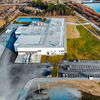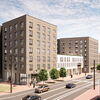Processing Your Payment
Please do not leave this page until complete. This can take a few moments.
- News
-
Editions
View Digital Editions
Biweekly Issues
- December 15, 2025
- December 1, 2025
- Nov. 17, 2025
- November 03, 2025
- October 20, 2025
- October 6, 2025
- + More
Special Editions
- Lists
- Viewpoints
-
Our Events
Event Info
Award Honorees
- Calendar
- Biz Marketplace
GrowSmart Maine 'transformative' award winners part of healthy growth focus
More Information
Projects that can transform a community, from Millinocket to Arundel, were named "outstanding" in this year's Smart Growth Awards from GrowSmart Maine, at the nonprofit advocacy group's second annual summit.
The conference, held at the Pepperell Mill complex in Biddeford Thursday, focused on development and other elements that affect the health of communities, large and small, across Maine. Participants not only attended workshops and discussions, but toured the host cities of Biddeford and Saco to experience some of the progress firsthand.
Named "Outstanding Projects" at the summit were the Northern Forest Center's Millinocket Housing Initiative; the Bethel Community Forest and Mahoosuc Pathways project; the design of Parris Terraces in Portland by Kaplan Thompson Architects; and the Charter Oaks Village Cooperative in Arundel and Biddeford.
Delilah Poupore, executive director of downtown group Heart of Biddeford, was recognized for Demonstrable Commitment to Smart Growth.
The awards "recognize the diverse activities that contribute to smart growth, and also serve as real-life illustrations of the benefits it can bring," a news release said. "This year’s winners showcase practical solutions to such challenges as the need for affordable housing, rebuilding downtowns and conserving land for public use."
Judges considered whether entries provided lessons that can be replicated statewide, and whether they had the potential to transform a neighborhood or community point of view, said Nancy Smith, executive director of GrowSmart Maine.
Judges were Charles Colgan, former Maine state economist; Evan Richert, former head of state planning and long-time Maine community planner; and Maureen Drouin, executive director of Maine Conservation Voters. (See sidebar for more on the award winners.)
Building, living healthy
The theme of this year's summit was Smart Growth Builds Wellness, a theme that stretched from talks about "well buildings" to affordable housing to land use and development.
"Health and wellness should be a right not a privilege," guest speaker Zoe Reich Margarites said in a keynote address. "For anyone with a roof over their head, that should be a requirement."
Margarites, vice president of market solutions for the International WELL Building Institute, said the physical and mental well-being of inhabitants should be taken into account for every type of building that people will be in, whether an office or a home.
She cited the Nature Conservancy's new headquarters at Fort Andross in Brunswick, which recently became the first structure in northern New England to be WELL building-certified by the institute. Certification covers everything from energy use and building materials to programs for the mental and physical health of those who work there.
"It's so exciting to see WELL-building standards penetrate the market here in Maine," she said.
Christopher Coes, vice president, land use and development for Smart Growth America, also delivered a keynote, and said suburban sprawl has become so pervasive in the U.S. that two of the last three recessions were real estate-related.
He said the new focus on living closer to jobs and services, cutting down on the need for extensive transportation and aiming for walkability, makes for healthier communities. And it's not only about people looking for a place to live — CEOs and entrepreneurs are also looking to locate in community centers.
"If you want to succeed in the 21st-century market, you have to be in places people want to live in," he said.
Tools for affordable housing
In a breakout session on how municipalities can find ways to create affordable housing, Jeff Levine, Portland's former director of planning and urban development, said, "Just getting people into a safe place to live is essential to a healthy community."
People can't contribute to the basic elements of healthy community living, for instance by recycling, if they don't have shelter, said Levine, now a lecturer of economic development and planning at Massachusetts Institute of Technology. "It's the last thing on your mind if you don't have a place to live."
Levine and Victoria Morales, executive director of the Quality Housing Coalition, discussed affordable housing solutions for municipalities. Some tools discussed were creating land trust for housing; using surplus municipal land; and linkage fees for developers who build market-rate housing;
"It doesn't need to be expensive or crazy," Levine said.
They also said developing an ordinance that allows higher-density projects if a developer includes low-income housing, rather than have developers seek contract zones specific to a project makes it easier to get affordable housing through the approval process.
"It can be painful and time-consuming" to go before town boards to get a contract zone — a zoning change specific to a project — Morales said. She said an overall zone that allows affordable housing is also more sustainable for town planning.
Tale of two cities
This is the first year that two municipalities — Biddeford and Saco — have hosted the conference.
Participants in the afternoon chose between walking tour "experience sessions" that highlighted different aspects of healthy growth in the communities. Tours included a look at the Riverwalk linking the two cities, Biddeford's food-ecosystem and the Pepperell Mill solar energy system; a tour focused on growing community through the arts, highlighting Biddeford's cultural features; a zoning-focused tour of Saco; and one that highlighted Saco's downtown development.
The Saco downtown development included a look at both development of former textile mills on Saco Island, which separates the two cities, as well as its robust Saco Main Street program.
The group toured Mill 4, which was developed into 150 market rate apartments and 30,000 square feet of commercial space by Chinburg Properties, one of the developers of the Lincoln Mill in Biddeford. The apartments opened last year, and two restaurants are among the tenants slated for the commercial space.
"When I first got here, this was vacant, dirty," said Rob Biggs, director of Saco Main Street.
Development funding included a tax increment financing district, which diverts development taxes to redevelopment projects, as well as historic preservation tax credits and other state and federal funding sources.
Matthew Dubois, of Chinburg, said that the apartments were fully rented out before the building opened.
The tour also included Saco's busy Main Street, where the stores and offices are almost fully occupied, Biggs said.
The city is one of 10 that are Main Street Maine municipalities, a program that highlights economic sustainability through vibrant downtowns that are walkable, preserve historic preservation, and more.
Anne Ball, director of the Maine Downtown Center, which coordinates the Main Street Maine program, said Saco's downtown in a great example of how a city center can thrive. "It's a whole Main Street approach that takes in design economic vitality, organization and promotion," she told the group.
Saco Main Street programs include everything from the use of Adirondack chairs, made by inmates of the Maine State Prison and painted by local artists, that are auctioned off at the end of the summer, to an ice cream shop it runs both to make money and serve as a community hub.
Biggs said that the proximity of residents, not only in neighborhoods that are right off Main Street but also new ones in the nearby former mills, helps add to downtown's vitality. He said that restaurants in the city core used to close early, but a push to keep them open into the evening has been successful. As a result, other businesses, seeing the activity, have located in downtown.
"People see what's happening here, and they want to be part of it," he said.
2019 Grow Smart Maine Smart Growth winners
Charter Oaks Village Cooperative is a manufactured housing community, partly in Arundel and partly in Biddeford, where the residents own their home but rent their lot. The community consists of 40 households who, for the most part, earn well below the median income for York County.
For almost 50 years, the park was owned and operated by a local “mom-and-pop” operator who took good care of the community and knew and cared about the residents, but they needed to retire and sell. The park was sold to a private equity investor from Las Vegas, "who immediately jacked up the rents and had plans to sell it off quickly for a large profit," representatives of the co-op said.
In June, after a concerted community organizing effort, the residents of the park bought te community to operate it as a resident-owned cooperative. By doing so, the resident homeowners took control of the land beneath their homes and now work together to operate the park on a cooperative basis, allowing the community to permanently remain affordable.
"The success of Charter Oaks brings positive attention and renewed interest in the preservation and development of compact neighborhoods of manufactured housing," GrowSmart Maine said. "Reducing the stigma of 'trailer parks' will put one of the most practical, cost-effective and resource efficient housing and development options back into the conversation about affordable housing, climate change, and walkable communities."
Millinocket Housing Initiative/Northern Forest Center. The housing initiative was launched by the Northern Forest Center in 2017 to support the Millinocket community by improving the quality of downtown housing to attract and retain workers and families. The Initiative acquired and renovated 10 distressed downtown Millinocket properties that presented high visibility opportunities to inspire further investment and downtown development.
The Initiative targeted a focal area in the heart of the community to connect the main street business district, former mill site (which is being developed into an innovation park), elementary school, hospital, library and more, which contributes to a more vibrant and walkable downtown. In coordination with the hospital, local non-profits, the town of Millinocket, and others, the Housing Initiative is a keystone of the community’s housing strategy and a major contributor to the overall revitalization of the community.
Northern Forest Center integrates economic, community, and environmental principles to gives rise to vibrant communities in a new forest future across Maine, New Hampshire, Vermont and New York.
Bethel Community Forest/Mahoosuc Pathways, in collaboration with the Trust for Public Land and the Northern Forest Center, the town of Bethel, donors, and area residents, piloted the creation of the 978-acre Bethel Community Forest. In 2019, Mahoosuc Pathways bought what is now the Bethel Community Forest on behalf of the town. The parcel had previously been targeted for housing development. Mahoosuc Pathways now manages the property for conservation, recreation and wildlife, providing infinite opportunity for recreational trail connectivity, education, recreation, health and wellness. It protects an important local snowmobile trail, protects traditional hunting lands, and protects one of the most productive deer wintering areas in the state.
"The Bethel Community Forest project presents an excellent example of how public land preservation can be achieved through the community forest model and serves as an example for other Maine communities to study and replicate," Grow Smart Maine said in presenting the award.
Kaplan Thompson Architects Parris Terraces. Kaplan Thompson Architects was selected to design 20 workforce housing apartments with no state or federal subsidy on former Portland Public Works Dept. property in West Bayside. Kaplan Thompson applied passive nouse techniques to create an optimized cost-effective system that prioritizes the health and well-being of residents, while requiring no fossil fuels to heat or cool. To protect this natural resource, Kaplan Thompson’s designed a system where all storm water from the building is treated onsite through a storm water rain garden of native plantings.
Parris Terraces comprises 23 housing units, affordable to people in a middle-income segment of the market largely unmet in the current Portland housing market. The project demonstrates that today’s “starter home” can be downtown, stylish, efficient, and affordable to working people GrowSmart Maine said.
Delilah Poupore, executive director of Heart of Biddeford, won the Demonstrable Commitment to Smart Growth Heart of Biddeford is one of Maine’s most successful and innovative Main Street organizations. In her role, which she's held since 2011, Poupore has become one of the city's most visible and credible advocates for positive change, inclusive decision-making, and a dynamic and a vibrant downtown that benefits the entire community.
A once-thriving mill town that fell on hard times with the closure of the mills, Biddeford is now one of the fastest growing and most desirable communities in southern Maine and has experienced a surge of economic revitalization. Poupore has played a key role in promoting, encouraging and facilitating much of this renewed vitality and growth by spearheading initiatives such as The Heart &Soul project, the city’s first Main Street Challenge, the Adopt-a-Park program, Music in the Park, the annual Downtown Holiday Festival, and the Halloween Trick-or-Treat event. Poupore has been called “the glue that holds downtown together” and is universally appreciated for her enthusiasm, energy and leadership.
Mainebiz web partners
Congratulations to the Charter Oaks Village Cooperative and all of the 2019 Award Winners. Thank you GrowSmart Maine for the important work you do.

The Giving Guide
The Giving Guide helps nonprofits have the opportunity to showcase and differentiate their organizations so that businesses better understand how they can contribute to a nonprofit’s mission and work.
Learn More
Work for ME
Work for ME is a workforce development tool to help Maine’s employers target Maine’s emerging workforce. Work for ME highlights each industry, its impact on Maine’s economy, the jobs available to entry-level workers, the training and education needed to get a career started.
Learn More
Groundbreaking Maine
Whether you’re a developer, financer, architect, or industry enthusiast, Groundbreaking Maine is crafted to be your go-to source for valuable insights in Maine’s real estate and construction community.
Learn more-
The Giving Guide
The Giving Guide helps nonprofits have the opportunity to showcase and differentiate their organizations so that businesses better understand how they can contribute to a nonprofit’s mission and work.
-
Work for ME
Work for ME is a workforce development tool to help Maine’s employers target Maine’s emerging workforce. Work for ME highlights each industry, its impact on Maine’s economy, the jobs available to entry-level workers, the training and education needed to get a career started.
-
Groundbreaking Maine
Whether you’re a developer, financer, architect, or industry enthusiast, Groundbreaking Maine is crafted to be your go-to source for valuable insights in Maine’s real estate and construction community.
ABOUT
NEW ENGLAND BUSINESS MEDIA SITES
No articles left
Get access now
In order to use this feature, we need some information from you. You can also login or register for a free account.
By clicking submit you are agreeing to our cookie usage and Privacy Policy
Already have an account? Login
Already have an account? Login
Want to create an account? Register
Get access now
In order to use this feature, we need some information from you. You can also login or register for a free account.
By clicking submit you are agreeing to our cookie usage and Privacy Policy
Already have an account? Login
Already have an account? Login
Want to create an account? Register







1 Comments